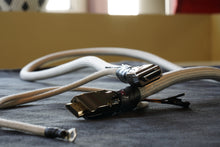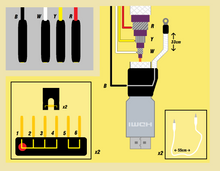HDMI^2 i2s Cable
Regular price
€290.00
Sale
The HDMI^2 is a most robust HDMI cable meant for audio and i2s connections.
Please notice : Although the technical specifications of the cable imply a possible length that exceeds 10m most easily for even 4K video, the possible length for i2s fully depends on the sending device. To this regard it is to be noticed that i2s officially is a chip-to-chip (wire) protocol, meant to be used at very short lengths (think 10cm). Longer is possible but the electrical driver of the sending device depicts the possible still working length. The cable itself is ultra low loss with e.g. max 2dB loss at 45MHz (max i2s frequency) for a whopping 10 meters.
As all ^2 series cables from Phasure, the HDMI^2 contains 3 screens / shields, each insulated from the other. The HDMI^2, like the ET^2, is extra special because it provides "output ground" wires to connect to the respective devices, with that forming additional shielding. Do notice that this is not HDMI-common at all as HDMI has no real standards for this. Mostly this is executed half-cooked and the internal shield may or may not make contact with the outermost part of the connecting part of the connector itself and if it does it may be higher (like 180K) or lower (like 14) Ohmic. With the HDMI^2 you can choose to connect the devices by means of the shield indeed and at both sides, one side only (either), or none at all.
Crocodile wires are provided to quickly test the ground wire(s) and if a suitable sounding setup has been found, the eyes to the end of the ground wires can be screwed more permanently to any suitable means for it.
Take notice : While the grounding wires do not provide ground to the HDMI wires anywhere, they will provide a ground connection between the two connected devises when both ends are connected to the respective device chassis indeed. That is, assumed the chassis is what the ground wires are connected to.
Of course you understood that while the extra grounding wires could physically be connected to their devices, it is the B(lack) wire of the ^2 topology which determines whether the ground wire really is connected through and if so, by means of which of the screens (W(hite) = Inner, Y(ellow) = Middle or R(ed) = Outer).
Important : The extra ground wires are shielded wires in itself, the shield not being connected to the "eye" at the ends. If you'd use the crocodile wires to test things or extend the ground wire with it, it is good to understand that the crocodile wires are not shielded.
Additional description on how this HDMI^2 cable is different from anything else
Apart from all the configuration possibilities (the ^2 part), this HDMI cable is special to audio because it takes into account the i2s connection explicitly;
Based on Phasure's experience on designing and building D/A converters at higher speed i2s connections (like 32 bits at 2ch 768KHz), such an actual chip-to-chip connection complies to a couple of standards or rules, not at all found in general HDMI cables, regardless of their price. This is all related to how the shields and the grounding is set up and how, for example, no device to device connection is desired through a shield which surrounds the high speed data wires; When we observe random HDMI cables and we measure the brass or chrome (or gold) HDMI'd end part of the connector (the part which physically slides into its receptor at e.g. the TV) from the one to the other, then you will be amazed about the various results you see. This is because there is no standard for this, the cables usually or often are made with metal connectors and the shield (braid) of the cable must go "somewhere" and is thus connected to the metal of the connector, that metal in itself touching that brass etc. end part which is not even by design but is so anyway. The result ? some coincidental half-connection which most often goes over the very loose (open) braid and from there implies a quite random resistance. Doesn't matter because the shield is not used for any connection anyway ?
Try to tell the latter to an audiophile who already knows how important a difference in potential can be from one device to the other, while his analogue interconnects make the connection between the two devices, the both now being on the same potential because of that but the current flowing over the signal path (the ground of it). This is analogue and can be quite devastating to the sound, but now we talk digital. And much worse : the subject now is our most fragile i2s connection and we surround our precious i2s high speed data with current to equal the potential of the devices ...
We can write the last paragraph 180 degrees differently just the same :
When we don't cause the potential difference to disappear by means of a shield which in itself is shielded again by more inner shields (still protecting the data), the current to cover for the potential difference will flow over the ground return of the i2s data wires (which includes clock wires). Ouch.
So you see ? you should be able to control this and the HDMI^2 setup allows for just that and in more than sufficient means to cover for any best situation. This, btw, includes connecting a shield to one end (device) only. We all know the tricks, but in this case the cable must allow for it or not deteriorate an inherently good situation to begin with (like a fixed shield connection would do while it should not be there).
Specifications (extended HDMI 2.0 4K with Ethernet)
- Shielded Twisted pair (ground + foil shield (100% coverage) and mylar insulation per pair (5x), + 4 separate wires, all 24AWG)
- Impedance 100 Ohm (+/- 15%) on all wire pairs
- Resistance 0,14 Ohm /m
- Bandwidth (end to end) 8Gb/s
- All grounding wires and foil shields insulated from each other
- General Foil (100% coverage) + first screen (shield), 80% coverage
- 2 extra screens (shields), 100% coverage, all shields insulated from each other
- Industrial heavy duty full metal connectors, gold-plated
- No standard connection of any shielding to the metal housing of the connector, nor to the 19pin end-connector itself
- Shielded ground wires at both ends for optional device-device connection via configurable cable shields
- With configured end to end (device-device) shield, the resistance is low-ohmic (like max 4 Ohm per meter)
- 225 configuration possibilities
- Cable diameter ~13mm
- Bending characteristic : 7cm radius (15cm outside diameter)
- Obtainable to 10m on request; longer on special request.




